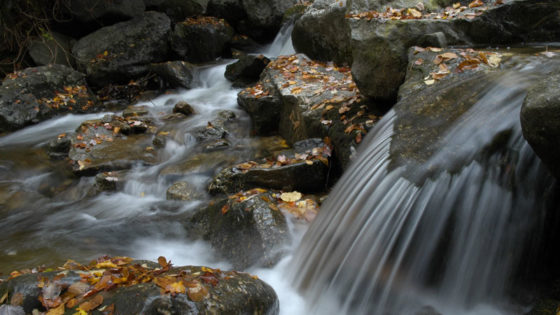Meet Jen Mosher: Post-Doctoral Associate
By Diane Huskinson
A SCIENTIST AT HEART
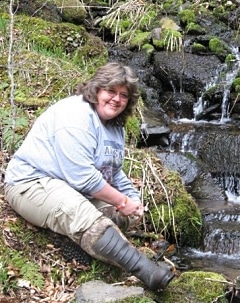
“I’ve always liked the outdoors. And science,” says Jen Mosher, Ph.D. “When I was a kid, I would turn over leaves, logs, everything while I was playing in the woods. I’ve always enjoyed trying to figure out how things work, especially in the outdoor environment.”
Growing up in rural Ohio, she found her bliss in the woods behind her house. “I was always back there either hiking or riding dirt bike.”
When asked if she comes from a family of scientists, Mosher laughs. “No, most of them are business-oriented. I was the odd one out. I used to have a tree house in the woods, and I would go and read books.”
As one of Stroud Water Research Center’s post-doctoral researchers, exploring the outdoors is in her job description, and she wouldn’t have it any other way.
“When I made the decision to focus my research, I had the choice between medical research and environmental research. Medical research bored me. I looked into it, and I just couldn’t do it.”
She likes the complexity of environmental science and how all the different geochemical parameters of an environment can shape a bacterial community.
“It’s fascinating, and because we may never fully know everything, it’s never boring.” I like a good puzzle.
SOLVING PUZZLES
The puzzles she’s working on for the Center are part of a collaborative effort to better understand how organic materials that dissolve out of leaves or algae or are excreted by organisms into stream water, called dissolved organic matter (DOM), change with distance downstream and affect the aquatic bacterial communities that feed on DOM.
Along with biogeochemist Lou Kaplan and microbiologist Jinjun Kan, both of Stroud Water Research Center, and Robert Findlay of the University of Alabama, Mosher is helping to build on the scientific theories set forth in the River Continuum Concept (RCC) first advanced by Robin L. Vannote in 1980. The RCC is the idea that a river is not a static body of water but rather a dynamic flow of ecosystems that varies throughout a river’s course.
For this metaecosystems project, they are working from three headwater streams: White Clay Creek in the Pennsylvania Piedmont, Río Tempisquito in the Cordillera de Guanacaste of Costa Rica, and the Neversink River in the Catskill Mountains of New York.
Mosher’s job is to analyze the bacteria the way psychiatrists analyze the psyche, probing ever so deeper to reveal the influencers and processes behind streams as they utilize carbon as part of the carbon cycle.
“Is the dissolved organic matter broken down by bacteria immediately? Is it partially broken down? Do bacteria downstream break down the bacteria even more? How fast is it broken down, and how does it affect the bacterial communities?” These are questions she and the research team are asking.
Why?
“Because a lot of it is about the efficiency of carbon uptake, which is helpful to understand when you have an abundance of carbon that contributes to global warming or climate change. We are looking at how the bacterial communities can retain the carbon and transform the carbon at the stream level,” she explains with enthusiasm.
THE LUCKY CAT
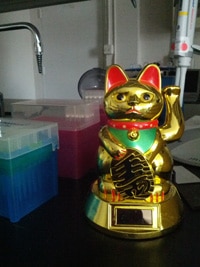
Between her vibrant personality and youthful voice and appearance, it’s hard to believe Mosher has nearly 20 years post-undergrad experience under her belt.
In the quality of her work, however, it shows. Kan says Mosher always has good successes with her experiments, and as a gesture, he gave her a lucky cat — believed to bring good luck to the owner — which now sits in the microbiology lab.
He says, “Jen is great. Her expertise bridges molecular microbial ecology with biogeochemistry, which is a hot topic in the field that leads to further understanding of the functional roles of microbes in natural environments.”
Her unique set of talents is also hard to find. Kaplan says, “There are very few people who are knowledgeable in both of the specialties we were looking for.”
“Like anyone approaching this level of expertise, she is smart, but what truly distinguishes Jen is her work ethic,” says Kaplan.
So strong is her work ethic that Kaplan sometimes reminds her to attend to life outside of scientific pursuits.
“I just love it,” she says. “I’m lucky to have found a career I enjoy so much that I sometimes forget to take time off.”
Post-doctoral positions, by design, last just two years. Mosher began hers in 2012, so while she continues to work on the metaecosystems project, she’s also searching for a faculty position, preferably teaching microbiology, microbial ecology, or microbial physiology.
Mosher says, “I am very fortunate to have the opportunity to be able to work with Lou, Jinjun, and others here at the Stroud Center. The stream ecology focus here allows me to apply techniques in which I specialize into a larger framework of ecosystem concepts.”
Students and Teachers Witness Stormwater Management in Action
By Christina Medved, Education Programs Manager
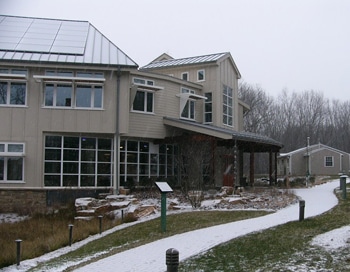
Photo: Christina Medved
The education department had an important role in planning what the new education laboratories and facilities now look like in the Moorhead Environmental Complex, and we had a lot to consider.
THINKING AHEAD
For example, we needed a place for 55 students and teachers to eat their lunches, so we suggested a stone wall around the wetlands. To plan for rainy days, we thought to design a covered front porch.
Though these may seem like minor considerations, it really matters when we host over two thousand students and adults annually, and since moving into the Complex this fall, we’ve benefited from our careful planning.
It’s only been four months that we’ve been using the new education facility. In that time, about 750 schoolchildren came through our doors. Moving students in and out of the building is easy now, and we appreciate all the space we have for hosting our young visitors.
REDUCING OUR FOOTPRINT
The students that came to the Center for a program last fall were not only recipients of a four-hour stream study; they also had a smaller environmental footprint during their visits.
Others may not think about their toilets very often, but we do. According to the U.S. Geological Society, an average toilet needs about three gallons of water for every flush. (I’m not referring to the newer low-flow toilets that only use about 1.5 gallons). Because of this fact, we decided to opt out of installing traditional toilets in the Complex and installed composting toilets by Clivus Multrum, Inc. That decision paid off tremendously.
Let’s do some math. If every student who visited us this fall used our bathrooms twice during their visit, that means that by using our no-water-needed-composting toilets, those students conserved 4,500 gallons of water! That’s about equal to the amount of water in a 4-foot-deep, 15-foot round swimming pool (source: www.backyardcitypools.com).
LIVING OUR MISSION
This is the kind of effect we had hoped to have on our future landowners, politicians, and voting citizens: making small changes, done in repetition, and having enormous long-term effects. Sometimes the things most remembered are not what are spoken but what are lived. And now, the features in the Complex are allowing us and our visitors to live out our mission.
We hope you visit us soon!
Stormwater Management: The Moorhead Environmental Complex manages stormwater with natural landscaping with permeable paving systems, a green roof and rain gardens with native vegetation.
Sustainable Water Use and Treatment: The Complex conserves water with a rainwater capture system, wetland wastewater treatment, composting toilets, and a water reuse system.
TEACHING TOOLS
When students gather by the huge rain barrel, we can ask them, ‘What features of this building prevent water from running off the land and carrying pollutants directly to the stream?’ Hands rise as they carefully look at the building and notice the green roof, the rain barrel, and the downspouts that lead to the rain gardens. — Vivian Williams, Education Programs Manager
The practical nature of the building makes teaching easier. We can take students to the Ruth Patrick Education Lab to finish the outdoor program when it is too cold or too wet. … A separate mudroom makes the transition from lab to outside and vice versa much easier. And all of the stormwater management features of the building provide concrete examples of our abstract lessons on water infiltration and eliminating stormwater runoff. — Libby Gregg, Education Programs Assistant
Chasing Dirtman Using Science and the Law
By Jamie Blaine
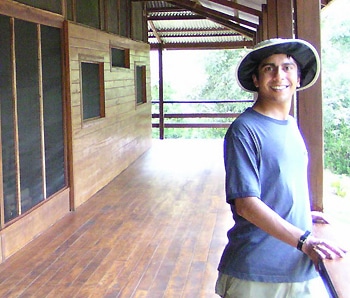
For Rajiv Shah, the line from studying “the enzymatic response of stream periphyton communities to stress” at Stroud Water Research Center to prosecuting criminals as a lawyer in the New York State Attorney General’s office has not been a straight one. Indeed, it has been a circle, taking him from studying New York City’s drinking-water supply to protecting it, as he recently helped send Anthony Adinolfi (more colorfully known as “Dirtman”) to prison for operating an illegal landfill next to one of the city’s reservoirs.
Shah first came to the Stroud Center as a student at the University of Pennsylvania. There, a field ecology course with Tom Bott led to his undergraduate thesis under Bott’s tutelage and subsequently to a research position during the final year of the six-year New York project. Shah next joined the research and education project in the Peruvian Amazon, where he worked on both microbiology research with Bott and spiraling with Denis Newbold. In his 16 months at the Center, Shah participated in two of the largest projects in its history and worked with some of its most eminent scientists, as well as its near-legendary staff scientist, Dave Montgomery. “Dave’s knowledge in the field is really unsurpassed,” said Shah. “He both expected a lot from me and went out of his way to make sure I was learning.”
During his time at the Center, Shah grew “from a student to a professional” in both work ethic and research skills. But it was his experience in Peru that most profoundly changed his life. Witnessing “perhaps the most important terrestrial ecosystem in the world being transformed by anthropomorphic activity, I came face to face with the disconnect between scientific knowledge and policy,” he said. “Seeing the prevalence of gold-mining in the rivers, burning large swaths of forest to clear areas for cattle, and logging Amazonian old growth forests, I realized that I wanted to translate scientific knowledge into sound policy/legal decisions,” which, as it happened, is precisely where the Center was driving its own mission.
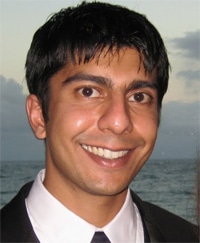
After an 18-month stint at Rockefeller University, working on a gene map of the mammalian brain, Shah set off for Fordham Law School. After several internships and clerkships, he arrived last August at the Environmental Crimes Unit in the Attorney General’s office, where he co-prosecuted “Dirtman” for dumping hundreds of truckloads of polluted waste near Croton Falls Reservoir in Putnam County.
“My experience at Stroud has been the foundation of my ability to grasp environmental law issues, particularly when it comes to water pollution,” Shah said.
“Indeed, there have been several situations where I have surprised people with my technical knowledge.” But he believes that the impact of his work at the Center goes beyond the methodological expertise he acquired there: “the legal process involves logic and induction skills similar to science,” he noted.” In the study and practice of law, the skills I developed through my technical background, at Stroud and elsewhere, have been invaluable.”
2012 a Successful Year
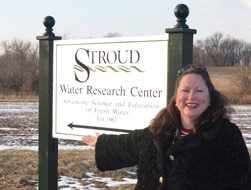
Kristine C. Lisi, Stroud Water Research Center’s development director, joined the Stroud Center’s staff in December 2011. With her leadership, 2012 was not only a successful year for development but also a record-breaking one! Check out these impressive accomplishments:
- When Lisi came to the Center on Dec. 19, 2011, the Annual Fund only had $170,000 raised toward its goal of $335,000. By the time the fiscal year closed on Dec. 31, the total amount raised had increased to $393,029 — the most ever until 2012.
- Another record was set in fiscal year 2012 with a total of $404,576 raised for the Annual Fund.
- The Capital Campaign totaled $5.6 million on Dec. 19, 2011. One year later, a total of $8.5 million has been raised.
- The Water’s Edge, the Center’s premiere fundraiser, raised a total of $177,782 in fiscal year 2012, which is the most the event has raised in the last four years.
- However, Lisi will tell you, in jest, that her greatest accomplishment was getting a new sign at the Center’s entrance on Spencer Road that’s big enough for visitors to see.
Many thanks to all those who supported the Center’s mission to advance knowledge and stewardship of fresh water through research and education. We couldn’t do it without you!
In the News
Storms and Trees: Stroud Study Cited
The University of Delaware’s student newspaper published a story on the pros and cons of planted trees during storm events. Citing a Stroud Water Research Center study, the article pointed to the reduction of stormwater runoff as a major plus.
Newbold Testimony Cited in Ongoing Coverage of Pipeline Approval
Stroud Center Research Scientist Emeritus Denis Newbold gave testimony at a public meeting in August about concerns over a permit the Department of Environmental Protection has granted Williams Transcontinental Gas and Pipeline Co. To read the latest story, check out “Fight over natural gas pipelines continue.”
Stroud Scientists and Educators Present
Our scientists and educators engage in both scientific and public forums to share their findings, increase awareness, and create a public dialogue centered on the protection, preservation, and restoration of watersheds everywhere. The following highlights recent presentations.
EarthCube Changes How Scientists Communicate, Workshop Springboard for Critical Zone Funding
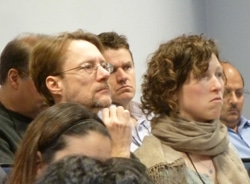
In January, the Christina River Basin Critical Zone Observatory (CRB-CZO) hosted a two-day EarthCube workshop at the University of Delaware. The EarthCube program, funded by the National Science Foundation (NSF), aims to transform the conduct of research through the development of community-guided cyberinfrastructure. The hope is to integrate information and data across geosciences disciplines that include earth, atmosphere, ocean, computer, information, and social scientists, educators, and data managers.
The workshop was organized and led by Anthony Aufdenkampe, Ph.D., with participation and support from several Stroud Water Research Center staff, including Susan Gill, Charles Dow, Dave Arscott, Shannon Hicks, Heather Brooks, Diana Karwan, and Jane Sowden. In all, nearly 60 researchers associated with the national network of Critical Zone Observatories attended in person with more than 30 people in virtual attendance. Outcomes of the workshop are expected to lead to a proposal to NSF’s program for Software Infrastructure for Sustained Innovation.

